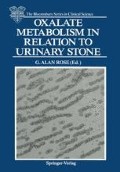Abstract
One of the recent advances in our understanding of calcium oxalate urolithiasis has been the recognition of the importance of hyperoxaluria in the pathogenesis of this large and growing problem (Robertson and Nordin 1969; Robertson et al. 1979; Robertson and Peacock 1980; Baggio et al. 1983; Antonacci et al. 1985; Jaeger et al. 1985). It must now be accepted that hyperoxaluria, albeit often mild, is a more important finding than hypercalciuria in many patients and indeed the presence of hypercalciuria should not prevent a thorough search for coexisting hyperoxaluria. Thus there is clearly a need for urinary oxalate to be estimated in all patients presenting with calcium oxalate stones and those laboratories serving clinics dealing with such patients should anticipate a growing demand for the precise and accurate assay of urinary oxalate.
Access this chapter
Tax calculation will be finalised at checkout
Purchases are for personal use only
Preview
Unable to display preview. Download preview PDF.
References
Antonacci A, Colussi G, De Ferrari ME et al. (1985) Calcium oxalate urine supersaturation in calcium stone formers: hypercalciuria versus hyperoxaluria. In: Schwille PO, Smith LH, Robertson WG, Vahlensieclc W (eds) Urolithiasis and related clinical research. Plenum Press, New York, pp 283–286
Baggio B, Gambaro G, Favaro S et al. (1983) Prevalence of hyperoxaluria in idiopathic calcium oxalate kidney stone disease. Nephron 35: 11–14
Bais R, Potezny N, Edwards JB et al. (1980) Oxalate determination by immobilised oxalate oxidase in a continuous flow system. Anal Chem 52: 508–511
Barlow IM (1987) Obviating interferences in the assay of urinary oxalate. Clin Chem 33: 855–858
Buttery JE, Ludvigsen N, Braiotta EA et al. (1983) Determination of urinary oxalate with commercially available oxalate oxidase. Clin Chem 29: 700–702
Chalmers AH, Cowley DM (1984) Urinary oxalate by rate analysis compared with gas chromatographic and centrifugal analyser methods. Clin Chem 30: 1891–1892
Costello J, Hatch M, Bourke E (1976) An enzymic method for the spectrophotometric determination of oxalic acid. J Lab Clin Med 87: 903–908
Hallson PC, Rose GA (1974) A simplified and rapid enzymatic method for the determination of urinary oxalate. Clin Chim Acta 55: 29–39
Hodgkinson A (1977) Oxalic acid in biology and medicine. Academic Press, New York, pp 62–103
Jaeger P, Portmann L, Jacquet A et al. (1985) Influence of the calcium content of the diet on the incidence of mild hyperoxaluria in idiopathic renal stone formers. Am J Nephrol 5: 40–44
Kasidas GP, Rose GA (1985a) Continuous flow assay for urinary oxalate using immobilized oxalate oxidase. Ann Clin Biochem 22: 412–419
Kasidas GP, Rose GA (1985b) Spontaneous in vitro generation of oxalate from L-ascorbate in some assays for urinary oxalate and its prevention. In: Schwille PO, Smith LH, Robertson WG, Vahlensieck W (eds) Urolithiasis and related clinical research. Plenum Press, New York, pp 653–656
Kasidas GP, Rose GA (1987) Removal of ascorbate from urine prior to assaying with a commercial oxalate kit. Clin Chim Acta 164: 215–221
Kohlbecker G (1981) Direct spectrophotometric determination of serum and urinary oxalate with oxalate oxidase. J Clin Chem Clin Biochem 19: 1103–1106
Laker MF, Hofmann AF, Meeuse BJD (1980) Spectrophotometric determination of urinary oxalate with oxalate oxidase prepared from moss. Clin Chem 26: 827–830
Mahle CJ, Menon M (1982) Determination of urinary oxalate by ion chromatography: preliminary observation. J Urol 127: 159–162
Mazzachi BC, Teubner JK, Ryall RL (1984) Factors affecting measurement of urinary oxalate. Clin Chem 30: 1339–1343
McWhinney BC, Cowley DM, Chalmers AH (1986) Simplified liquid chromatographic method for measuring urinary oxalate. J Chromatogr. 383: 137–141
Obzansky DM, Richardson KE (1983) Quantification of urinary oxalate with oxalate oxidase from beet stems. Clin Chem 29: 1815–1819
Robertson WG, Nordin BEC (1969) Activity products in urine. In: Hodgkinson A, Nordin BEC (eds) Renal Stone Research Symposium. Churchill, London, pp 221–232
Robertson WG, Peacock M (1980) The cause of idiopathic calcium stone disease: hypercalciuria or hyperoxaluria: Nephron 26? 105–110
Robertson WG, Rutherford A (1980) Aspects of the analysis of oxalate in urine — a review. Scand J Urol Nephrol [Supp] 53: 85–95
Robertson WG, Peacock M, Heyburn PJ et al. (1979) The significance of mild hyperoxaluria in calcium stone formation. In: Rose GA, Robertson WG, Watts RWE (eds) Oxalate in biochemistry and clinical pathology. Wellcome Foundation, London, pp 173–180
Shepherd MDS, Penberthy LA (1987) Performance of quantitative urine analysis in Australasia critically assessed. Clin Chem 33: 792–795
Zerwekh JE, Drake E, Gregory J et al. (1983) Assay of urinary oxalate: six methodologies compared. Clin Chem 29: 1977–1980
Editor information
Editors and Affiliations
Rights and permissions
Copyright information
© 1988 Springer-Verlag Berlin Heidelberg
About this chapter
Cite this chapter
Samuell, C.T. (1988). Experiences with an External Quality Assessment Scheme for Urinary Oxalate. In: Rose, G.A. (eds) Oxalate Metabolism in Relation to Urinary Stone. The Bloomsbury Series in Clinical Science. Springer, London. https://doi.org/10.1007/978-1-4471-1626-4_3
Download citation
DOI: https://doi.org/10.1007/978-1-4471-1626-4_3
Publisher Name: Springer, London
Print ISBN: 978-1-4471-1628-8
Online ISBN: 978-1-4471-1626-4
eBook Packages: Springer Book Archive

